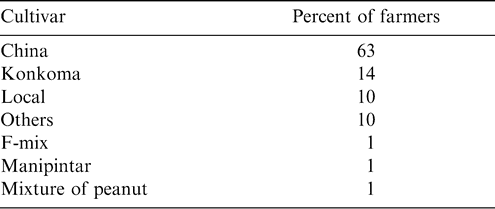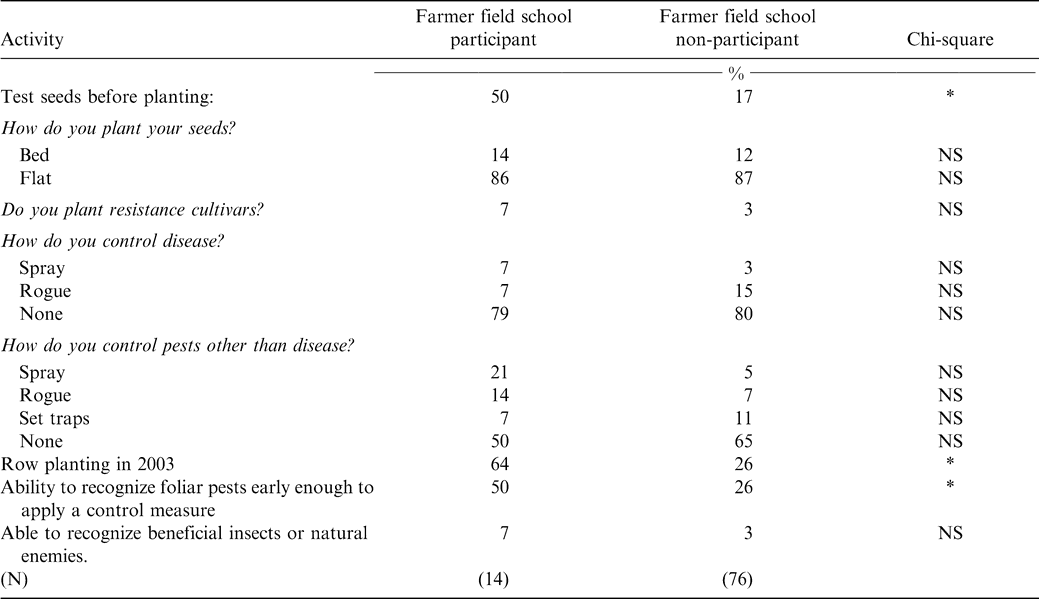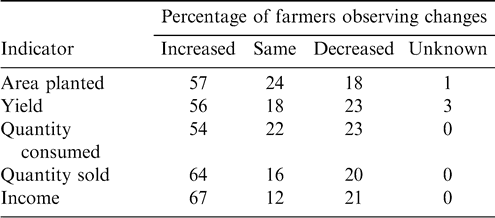Introduction
Groundnut is an important food and cash crop in Ghana and other countries in West Africa (Debrah and Waliyer, 1996). A variety of biotic and abiotic stresses can reduce peanut yield (Attuahene-Amankwah et al., 1990), and developing and implementing sustainable practices to manage these pests are important. Successful transfer of new technologies to farmers can be challenging as sociological aspects can influence acceptance of new technologies. In the development of appropriate technologies for farmers, it is imperative to understand the production practices and conditions of the farmers (CIMMYT, 1988). Information from surveys can be used to orient research and extension activities and to plan research and provide baseline information that can be used in future impact assessments (Tripp and Woolley, 1989). The underlying importance of monitoring and evaluation including impact assessment, as a planning tool to facilitate effective research management cannot be overemphasized (Mudhara et al., 1997).
Understanding how peanut farmers in Ghana perceive the benefits of integrated pest management (IPM) is important in developing methods to transfer technology to a wide range of farmers in order to increase yield. A collaborative IPM program was developed among scientists and practitioners at North Carolina State University (US) and the Crops Research Institute (Ghana) to develop a research base for peanut production and pest management and to extend pertinent findings to peanut farmers in the region. Sound agronomic practices are one of the most feasible and practical ways for controlling aflatoxin (caused by Aspergillums flavus) because fungal attack may begin in the field at pre-harvest (Dorner et al., 1992). Preventing aflatoxin contamination at pre-harvest requires high quality seed (Ellis, 1999). One component of this project was to survey farmers and determine what pest management practices are currently being implemented and to define factors that influence farmer acceptance of new technologies. The survey also sought to provide some baseline information upon which future impact on pest management practices could be compared. The objective of project was to develop and transfer production technologies that will reduce negative impact of pests and increase yield.
Materials and Methods
A survey of 90 farmers was conducted between September 5 and 14, 2003 in the Ashanti Region of Ghana, West Africa in the Hiawoanwu, Bonyo, Dromankuma, and Ejura villages in the Ejura-Sekyedumase district. The survey consisted of questions related to production and pest management practices by farmers in the region. Additionally, farmer field schools consisted of 20 farmers exposed to a variety of pest management and production practices including land preparation, seed and cultivar selection, production practices, pest management, fertility, and post-harvest handling during the peanut production cycle from 2002 and 2003. Farmers and researchers met bi-weekly at one on-farm site to follow crop development and discuss production and pest management issues. Chi-square test was used to compare responses (Steel and Torrie, 1980).
Results and Discussion
Survey Responses
Mean age of farmers was 40.9 years, and the number of years farmers received formal education was 3.8 years (Table 1). The mean number of male and female adults over 18 years in farmer's households was 3.38 and 3.12, respectively (Table 1). The mean number of the farmer's own children was 4.4. Although farmers received relatively little formal education, farmers produced peanut on average 8.5 years (Table 1). The mean percent of total annual income from peanut was 41.9 (Table 1). Fifty-seven percent of the farmers owned the land, 36% cash rented, 2% sharecropped, and 5% had other land arrangements (Table 1).
Only 6% of respondents received financial credit for production of peanut (data not presented). Four percent received loans from local banks while the other two percent of respondents received credit that came from Non-Governmental Organizations (NGO) or family members (data not presented).
Ninety-two percent of the 90 farmers planted peanut as a monocrop system, with the majority of farmers planting only one field of peanut per year (data not presented). The majority of the farmers (73 of 90) cultivated only one field of peanut in 2003 (data not presented). Sixteen percent of farmers cultivated two fields while 3% of respondents cultivated more than two fields of peanut (data not presented). The mean size of the largest field cultivated in 2003 was 0.68 ha (Table 1). Fields were tilled using tractors by 96% of the farmers. Only two percent of respondents used animals to till and another 2% planted without tillage.
The cultivar China was planted by 63% of farmers (Table 2). The cultivar Konkoma was planted by 14% of farmers while a combined total of 20% of cultivars was either of local origin or not defined in the survey. F-mix, Manipintar, and a mixture of cultivars were planted by 3% of farmers collectively. Cultivars planted by 73% of the farmers were estimated to be mature in approximately 90 days after planting while 23% of respondents indicated that cultivars required at least 120 days to reach optimum maturity (data not presented).
Farmers began planting peanut between January and September with 30% planting in March, 28% in April, and 16% in August (data not presented). This region of Ghana has two rainy seasons with one running from March through July (major season) and a second running from September through October (minor season). Seventy-seven percent of respondents planted during the major rainy season while the remaining 23% planted peanut during the September through October period (data not presented).
The majority of the farmers (87%) tilled their fields and planted flat with only 12% planting on ridges and only 1% planting on mounds (data not presented). Thirty-two percent of the farmers planted peanut in rows and 68% planted at random. Only 2% of the farmer's applied synthetic fertilizer to improve their soil fertility and increase peanut yield, and just 1% used animal manure to increase soil fertility (data not presented).
Rosette, a viral disease transmitted by aphids (Aphis craccivora) and early leaf spot [Cercospora arahidicola (S.) Hori] were mentioned by 51% and 44% of the farmers, respectively, as the most yield-limiting diseases (data not presented). Rust (Puccinia arachidis) was mentioned by less than 3% of farmers as a significant problem. Eighty-two percent of farmers did not introduce any control measure for disease. Thirteen percent removed diseased plants while 4% sprayed a local soap or synthetic fungicide to suppress foliar disease.
Squirrel (Myosciurus spp.) and rabbit (Oryctolagu spp.) were mentioned by 74% and 3% of the farmers, respectively, as mammals affecting peanut production. Millipedes (Myriapoda: Diplopoda) were mentioned by 13% of the farmers (data not presented). In terms of controlling these pests, 74% of respondents did nothing, 10% set traps, 8% sprayed, and 8% physically removed pests (data not presented). Eighty-eight percent of the farmers weeded once and 12% weeded twice (data not presented). Eighty-nine percent of the farmers used manual weeding with hoe or cutlass and only 11% applied herbicides (data not presented).
Eighty-eight percent of the farmer's stored peanut unshelled and 12% of farmers shelled peanut prior to storage. Reasons given for storing in unshelled condition were that no chemicals were needed (17%), extending shell life (52%), avoiding insects (20%), high prices of peanut (6%), and 6% did not give a reason for storage approach.
Peanut was marketed virtually throughout the year, however, peaks of marketing were observed in March and November (data not presented). Marketing constraints listed by respondents included traders dictating prices (29%) and low prices (32%) while 36% indicated that they had no constraints to marketing peanut (data not presented).
Involvement and Potential Output From Farmer Field School Activities
Twenty of the 90 farmers in the original survey were involved in farmer field school activities during 2002 and 2003 (data not presented). Only 5% attended farmer field schools prior to 2002 (data not presented).
Determining seed germination was an important component of the farmer field school. Forty percent of farmers implemented seed germination tests after observing this technique at farmer field schools (Table 3). Thirty-five and 20% of respondents discovered this approach from other farmers or from research and extension collaborators, respectively. Five percent of respondents learned of this technique from radio programs. The percentage of farmers using seed germination tests prior to 2002 ranged from 4 to 23% (data not presented). Forty-five percent of respondents implemented this technique in 2003.
The majority of respondents had never planted a disease-resistant cultivar (97%, data not presented). Ninety-one percent of farmers did not know host-plant resistance was a possibility while 9% indicated that searching for resistant cultivars was extremely time consuming (data not presented).
Demonstrating planting peanut in rows rather than at random was an important component of the farmer field schools. In 2003, 32% of farmers seeded peanut in rows. Fifty-five percent of the farmers planting in rows indicated that they modeled this approach after other farmers (Table 4). Seventeen and 21% of respondents indicated that they learned this approach through the farmer field schools or Extension, respectively. Seven percent learned this approach from local radio broadcasts. Of the respondents who did not plant in rows, 69% indicated that this approach of production required too much time, while 28% indicated that they did know how to plant peanut in rows (data not presented).
Accurate identification of pests and the damage they cause is an essential component of IPM. Only 29% of farmers indicated that they could accurately identify pests (data not presented). Additionally, only 3% of farmers could identify beneficial insects (data not presented). Of those farmers who could identify pests, farmer field schools were mentioned as the source of information.
Fifty percent of farmer school participants tested seeds for germination prior to planting compared with only 17% of non-participants (Table 5). No differences were noted when comparing whether or not farmers in either category planted on beds, methods employed to control disease and other pests, and their ability to recognize beneficial pests. However, farmers attending farmer field schools adopted row planting, and these farmers were better able to identify pests and their damage compared to non-participants.
The majority of farmers indicated that area planted, yield, quantity of peanut sold and consumed, and income increased over the duration of the farmer field school initiative (Table 6). Results from this survey and farmer field schools have defined current production and pest management practices for peanut production in one region of Ghana. These data can serve as a baseline for determining research objectives and areas of outreach by Extension colleagues. Addressing issues associated with soil fertility and developing sustainable pest management practices are areas where increased research is needed and development of alternatives considered. Harvesting and storing practices also need to be addressed and improved.
Acknowledgements
The Peanut CRSP, USAID (LAG-G-0096-90013-00), supported this research financially.
Literature Cited
Attuahene-Amankwah G. , Hossain M. A. , and Asibi M. A. 1990 Peanut production and improvement in Ghana. In ICRISAT 1990. Summary Proceedings of the First Reg. Peanut Mtg. for West Africa. September, 13–16, 1988 ICRISAT Sahelian Center, Niamey, Niger, ICRISAT Patancheru, India .
CIMMYT 1988 From Agronomic Data to Farmer Recommendations: An Economics Training Manual. Revised edition. Mexico, D.F.
Debrah S. K. and Waliyar F. 1996 Groundnut production and utilization in Africa; past trends; projections and opportunities for increased production. Paper delivered at the 5th Regional Groundnut Workshop for West Africa. Nov. 18–21, 1996. Accra, Ghana.
Dorner J. W. , Cole R. J. , and Blankenship P. D. 1992 Use of biocompetitive agent to control preharvest aflatoxin in drought stressed peanuts. J. Food Protection 55 : 888 – 892 .
Ellis W. O. 1999 Recommendations for controlling fungal growth and aflatoxin production in groundnuts. 19 – 21 In Awuah R. T. and Ellis W. O. eds. Proc. Nat. Workshop on Peanut and Peanut Aflatoxins. 19–21 September, 1999, Santasi, Kumasi, Ghana
Mudhara M. P. , Anandajayasekeram D. , Martella E. , Mazhangara E. , and Murata M. 1997 1 – 2 In Impact Assessment of Soybean Research and the Enabling Environment in Zimbabwe: 1965–2000 Published by SACCAR Gaborone, Botswana .
Steel R. G. D. and Torrie J. H. 1980 Principles and Procedures of Statistics: a Biometric Approach, 2nd edition McGraw-Hill, Inc .
Tripp R. and Woolley J. 1989 The Planning Stage of On-Farm Research: Identifying Factors of Experimentation Mexico, D.F.Cali, Colombia CIMMYT and CIAT .







